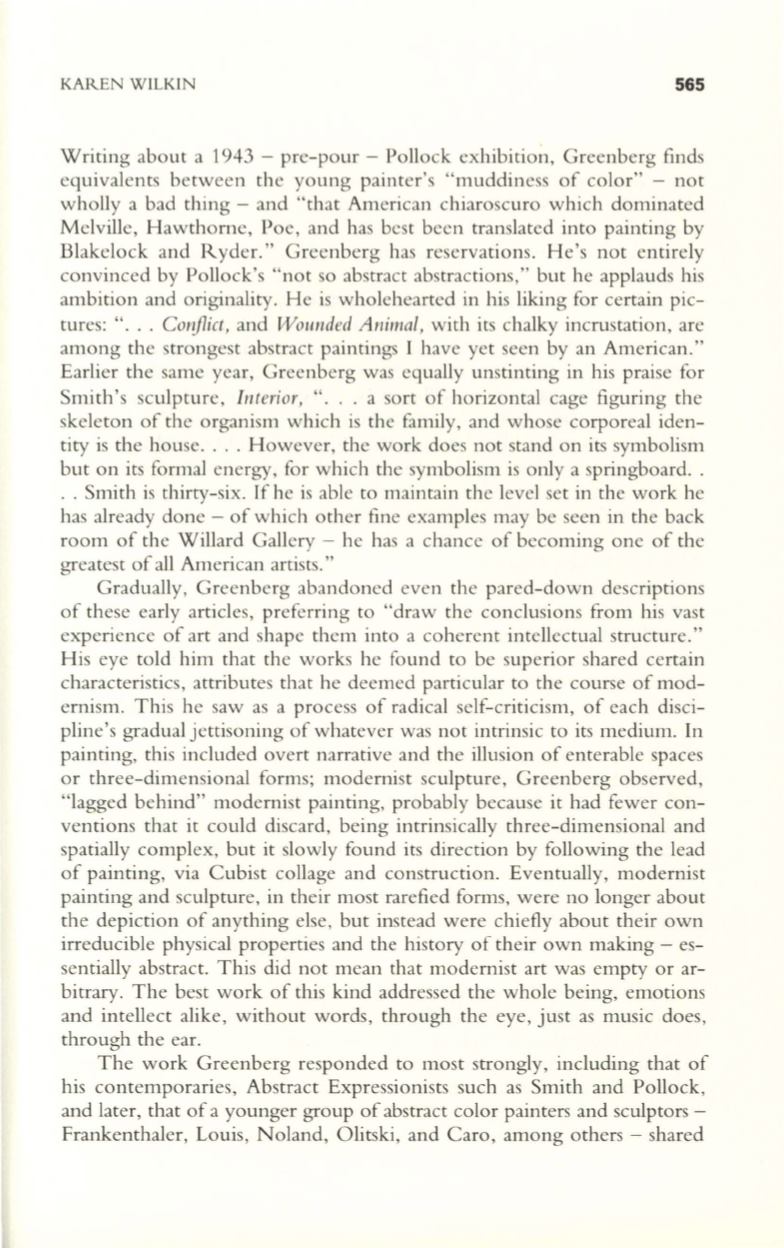
KAREN WILKIN
565
Writing about a 1943 - pre-pour - Pollock exhibition, Greenberg finds
equivalents between the young painter's "muddiness of color" - not
wholly a bad thing - and "that American chiaroscuro which dominated
Melville, Hawthorne, Poe, and has best been translated into painting by
Blakelock and Ryder." Greenberg has reservations. He's not entirely
convinced by Pollock's "not so abstract abstractions," but he applauds his
ambition and originality. He is wholehearted in his liking for certain pic–
tures: " ...
Conflict,
and
Wounded Animal,
with its chalky incrustation, are
among the strongest abstract paintings I have yet seen by an American."
Earlier the same year, Greenberg was equally unstinting in his praise for
Smith's sculpture,
Interior,
" ...
a sort of horizontal cage figuring the
skeleton of the organism which is the family, and whose corporeal iden–
tity is the house.... However, the work does not stand on its symbolism
but on its formal energy, for which the symbolism is only a springboard..
. . Smith is thirty-six. If he is able to maintain the level set in the work he
has already done - of which other fine examples may be seen in the back
room of the Willard Gallery - he has a chance of becoming one of the
greatest of all American artists."
Gradually, Greenberg abandoned even the pared-down descriptions
of these early articles, preferring to "draw the conclusions from his vast
experience of art and shape them into a coherent intellectual structure."
His eye told him that the works he found to be superior shared certain
characteristics, attributes that he deemed particular to the course of mod–
ernism. This he saw as a process of radical self- criticism, of each disci–
pline's gradual jettisoning of whatever was not intrinsic to its medium. In
painting, this included overt narrative and the illusion of enterable spaces
or three-dimensional forms; modernist sculpture, Greenberg observed,
"lagged behind" modernist painting, probably because it had fewer con–
ventions that it could discard, being intrinsically three-dimensional and
spatially complex, but it slowly found its direction by following the lead
of painting, via Cubist collage and construction. Eventually, modernist
painting and sculpture, in their most rarefied forms, were no longer about
the depiction of anything else, but instead were chiefly about their own
irreducible physical properties and the history of their own making - es–
sentially abstract. This did not mean that modernist art was empty or ar–
bitrary. The best work of this kind addressed the whole being, emotions
and intellect alike, without words, through the eye, just as music does,
through the ear.
The work Greenberg responded to most strongly, including that of
his contemporaries, Abstract Expressionists such as Smith and Pollock,
and later, that of a younger group of abstract color painters and sculptors -
Frankenthaler, Louis, Noland, Olitski, and Caro, among others - shared


